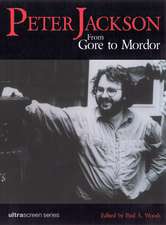The American Television Industry: International Screen Industries
Autor Michael Curtin, Jane Shattucen Limba Engleză Paperback – 11 noi 2009
Din seria International Screen Industries
- 14%
 Preț: 179.10 lei
Preț: 179.10 lei - 28%
 Preț: 180.71 lei
Preț: 180.71 lei - 7%
 Preț: 161.76 lei
Preț: 161.76 lei - 30%
 Preț: 574.51 lei
Preț: 574.51 lei - 30%
 Preț: 509.93 lei
Preț: 509.93 lei - 13%
 Preț: 168.15 lei
Preț: 168.15 lei -
 Preț: 230.61 lei
Preț: 230.61 lei -
 Preț: 222.74 lei
Preț: 222.74 lei -
 Preț: 231.06 lei
Preț: 231.06 lei -
 Preț: 233.37 lei
Preț: 233.37 lei -
 Preț: 225.06 lei
Preț: 225.06 lei -
 Preț: 225.57 lei
Preț: 225.57 lei -
 Preț: 197.65 lei
Preț: 197.65 lei - 12%
 Preț: 217.69 lei
Preț: 217.69 lei -
 Preț: 196.79 lei
Preț: 196.79 lei - 20%
 Preț: 197.34 lei
Preț: 197.34 lei -
 Preț: 189.14 lei
Preț: 189.14 lei
Preț: 223.67 lei
Nou
Puncte Express: 336
Preț estimativ în valută:
42.81€ • 44.52$ • 35.88£
42.81€ • 44.52$ • 35.88£
Carte disponibilă
Livrare economică 20 februarie-06 martie
Preluare comenzi: 021 569.72.76
Specificații
ISBN-13: 9781844573370
ISBN-10: 1844573370
Pagini: 202
Ilustrații: 19 b/w photos, 1 b/w illustrations
Dimensiuni: 155 x 235 x 13 mm
Greutate: 0.32 kg
Ediția:2009
Editura: British Film Institute
Colecția British Film Institute
Seria International Screen Industries
Locul publicării:London, United Kingdom
ISBN-10: 1844573370
Pagini: 202
Ilustrații: 19 b/w photos, 1 b/w illustrations
Dimensiuni: 155 x 235 x 13 mm
Greutate: 0.32 kg
Ediția:2009
Editura: British Film Institute
Colecția British Film Institute
Seria International Screen Industries
Locul publicării:London, United Kingdom
Cuprins
Introduction.-
1
Key
Players.-
2
Audiences
and
Advertising.-
3
Television
Programming.-
4
Making
TV
on
the
Broadcast
Networks.-
5
Branded
Cable
Networks.-
6
The
New
Economies
of
TV
Information.-
Conclusion.-
Bibliography.-
Index.
Notă biografică
MICHAEL CURTIN is the Mellichamp Professor of Global Media in the Department of Film and Media Studies at University of California, Santa Barbara. He is the author ofRedeeming the Wasteland: Television Documentary and Cold War Politics(Rutgers, 1996) andPlaying to the World's Largest Audience: The Globalization of Chinese Film and TV(2008), and the co-editor, with Lynn Spigel, of 'The Revolution Wasn't Televised: Sixties Television and Social Conflict' (1997) and, with Richard Ohmann, Gage Averill, David Shumway and Elizabeth Traube, of 'Making and Selling Culture' (1996).
JANE SHATTUC is Professor of Visual and Media Arts at Emerson College, Boston, USA. She has written primarily about American and European television industries and how their aesthetic and industrial forms relate to class and gender. Her books include:Television, Tabloids, Tears: Fassbinder and Popular Culture(1995) andThe Talking Cure: TV Talk Shows and Women(1997). She co-editedHop on Pop: the Politics and Pleasures of Popular Culture(2002) with Henry Jenkins and Tara McPherson.
Series Editors: Michael Curtin, University of California, Santa Barbara and Paul McDonald, University of Portsmouth
Textul de pe ultima copertă
In an age of proliferating choices, television nevertheless remains the most popular medium in the United States. Americans spend more time with TV than ever before, and many 'new media' forms, such as blu-ray movies, Hulu videos, and Internet widgets, are produced and delivered by the world's most lucrative and powerful television industry. Yet that industry has undergone profound changes since the 1980s, moving from a three-network oligopoly to a sprawling range of channels and services dominated by a handful of major conglomerates. Viewers can now access hundreds of channels at all hours of the day and can search and select from hundreds of thousands of individual programmes on video and Internet services. This diversity has fragmented the size of television audiences and transformed relationships between viewers and television companies. Unlike the first fifty years of television, today's industry leaders can no longer rely on mass audiences and steady revenue flows from big-budget advertisers, and this in turn affects their programming and production strategies.
The American Television Industryoffers a concise and accessible introduction to TV production, programming, advertising and distribution. Michael Curtin and Jane Shattuc outline how programmes are made and marketed, and provide an insightful overview of key players, practices and future trends. Although star-driven dramas and comedies continue to attract a great deal of critical praise and audience attention, television is increasingly characterised by niche programming services, that, with modest production budgets, compete for audience attention. In this environment, reality TV genres have emerged as attractive programming alternatives for cable services such as the History Channel and the Food Network. Moreover, programming is increasingly delivered on an a la carte, on-demand basis to a diverse array of viewing devices, such as iPods and cell phones.
The book analyses the corporate strategies, technological innovations and cultural transformations that have driven changes in industry strategy, discourse and practice. Making reference to numerous case examples, the authors identify definitive trends and describe key players in industry and government. These are indeed vibrant but unstable times for the American television industry and this volume explains the major forces that will shape the future of the medium in North America and around the world.
Caracteristici
Up
to
date
incorporating
recent
developments
and
current
issues
Authors are two very high profile US television scholars
Includes studentfriendly case studies and illustrations
Authors are two very high profile US television scholars
Includes studentfriendly case studies and illustrations










